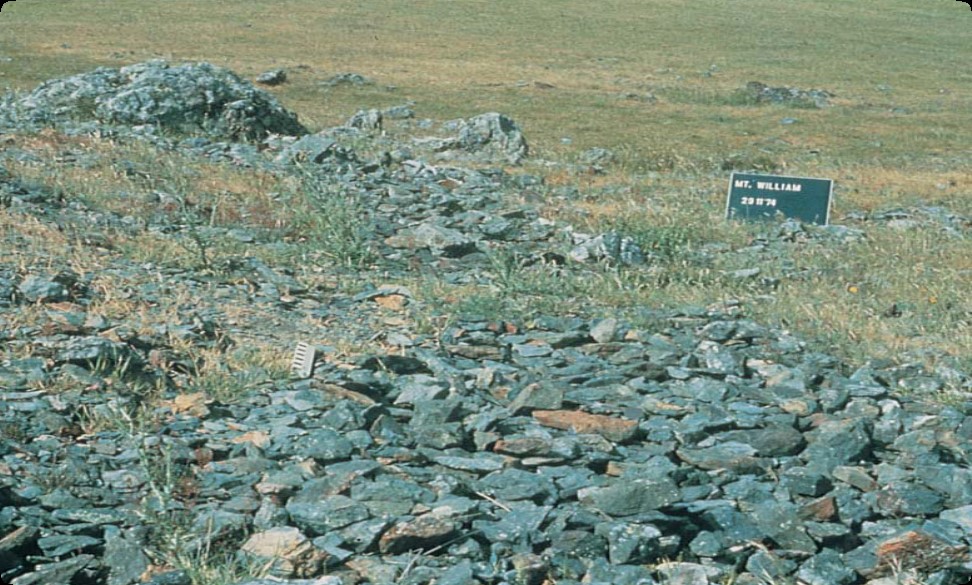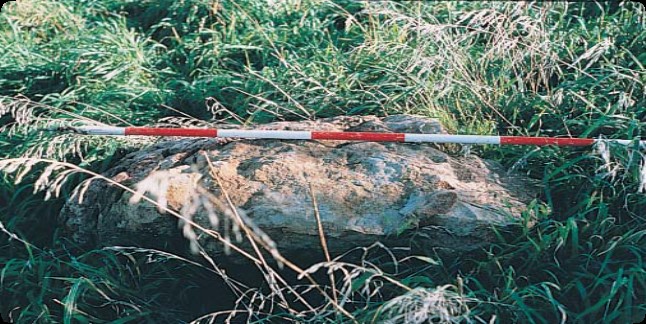Characteristics
- the rock is a type that can be made into stone tools, such as greenstone, silcrete and quartzite
- the outcrop bears scars from flaking, crushing and battering
- pits and trenches are found around the base of the outcrop
- large amounts of broken stone, particularly flakes, are the same type of stone as the outcrop
- identifiable stone artefacts, such as unfinished tools, hammerstones, anvils and grinding stones may be around the site
What is an Aboriginal quarry?
Aboriginal quarries are places where Aboriginal people took stone from rocky outcrops to make chipped or ground stone tools for many different purposes.
Not all types of stone were suitable for making tools, so an outcrop of good stone that could be easily quarried was a valuable resource.
Aboriginal people quarried different types of stone, each with its own special value and use. Stone tools were made from greenstone, silcrete, quartz, quartzite, basalt and chert. Pigments were made from quarried ochre, and grinding tools were made from sandstone.
Some quarries are small, consisting of just a single protruding boulder. Other quarries incorporate many outcrops and areas of broken stone that cover thousands of square metres.
Where are quarries found?
Aboriginal quarries are generally found on slopes where erosion has exposed the stone, for example, the slopes above creeks and rivers, on the sides of old volcanoes and on ridges.
How did Aboriginal people quarry stone?
Aboriginal people used at least two methods of stone quarrying. One method was to strike the surface of the outcrop at an angle with a hammerstone. Manageable pieces of stone broke off with minimum effort. This method scarred the rock face and left scattered broken fragments around the outcrop. The hammerstone was sometimes left at the quarry site.
The other method involved digging around and under outcrops to find buried stone. The purpose was to find manageable chunks of stone that were unweathered. Such digging created pits and trenches.
The early stages of stone tool making often occurred at the quarry. Tool manufacture added to the debris produced by quarrying. Aboriginal people used hammerstones, anvils and grinding stones, which were often left at the quarry because they were heavy. Sometimes, unfinished tools such as ‘axe blanks’ (see fact sheet on ground-edge axes) were also left behind.
What else looks like Aboriginal quarrying?
Natural weathering can create outcrops that appear similar to Aboriginal quarries. Uneven fractures and splintering on the outcrop face can resemble flaking scars. Weathering also produces large quantities of angular pieces of stone that look like stone tools. First Peoples - State Relations can provide an expert assessment of your discovery.
Why are Aboriginal quarries important?
Aboriginal quarries tell us a lot about Aboriginal stone tools, such as the types of stone used, how stone was obtained, and how the tools were made.
Aboriginal quarries also provide a rare glimpse into the fabric of past Aboriginal society. Quarried stone was often traded. Stone axes from one of the most important quarries in Victoria, at Mount William (Wil-im-ee Mooring) near Lancefield, have been found right across south-east Australia.
Knowing where stone was quarried, we can learn more about the networks that existed between different groups of Aboriginal people. Most importantly, quarries are an important link for Aboriginal people today with their culture and their past.
Are Aboriginal quarries under threat?
Human activities such as mining, road building, damming, clearing and construction can disturb or destroy Aboriginal quarries. Natural processes such as weathering and erosion can also cause the gradual breakdown of stone outcrops.
First Peoples - State Relations records the location, dimensions and condition of Aboriginal quarries. The aim is to have a permanent record of this important part of the heritage of all Australians.
Management works around Aboriginal quarries, such as stock and erosion control, help preserve the sites for future generations.
Are Aboriginal quarries protected?
All Aboriginal cultural places in Victoria are protected by law. Aboriginal artefacts are also protected.
It is illegal to disturb or destroy an Aboriginal place. Artefacts should not be removed from the site.
What to do if you find an Aboriginal quarry
- do not disturb the place or remove any material
- check whether the place has the typical characteristics of an Aboriginal quarry
- if it does, record its location and write a brief description of its condition
- note whether it is under threat of disturbance
- please help to preserve Aboriginal cultural places by reporting their presence to First Peoples - State Relations.
Updated



